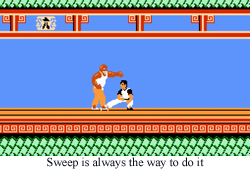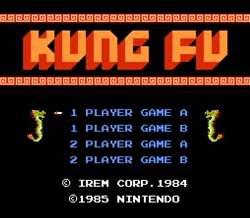 Kung-Fu is the NES port of Kung-Fu Master, an arcade game originally intended to be based on Jackie Chan’s 1984 film, Wheels on Meals. By all accounts, such a dubious origin should not be the foundation for every fighting game that has ever been produced, but, hey, here we are.
Kung-Fu is the NES port of Kung-Fu Master, an arcade game originally intended to be based on Jackie Chan’s 1984 film, Wheels on Meals. By all accounts, such a dubious origin should not be the foundation for every fighting game that has ever been produced, but, hey, here we are.
Kung-Fu originates from the early “arcade” era of videogames, a time when “fun” had to be carefully balanced with “player will never ever succeed”. Kung-Fu appeased these twin masters with a fun, interesting gauntlet of unlimited, faceless mooks that want nothing more than to see your immediate death. Everyone remembers the bizarre “man train” of random dudes, but those that actually had the quarters to finish Kung-Fu also encountered dragons, moths, and a unusually high number of acrobatic dwarves. Each stage finished with a unique boss, and the final level of the pagoda hosted none other than Chuck Norris. Or maybe that guy from Karate Kid? Look, it doesn’t matter, the point is that that guy is capable of some punishing kicks, so trouncing him and reclaiming the captured Sylvia felt like a real accomplishment. And then the whole thing looped back to the beginning (complete with a bit of text that seems to imply that Sylvia is a professional kidnapping victim), because an arcade is not happy until you leave the place a penniless (quarterless) hobo.
Now, to be honest, that account could describe a number of games. Who is Mario but an average dude that deals with generic/murderous monsters on his way through a castle to rescue a princess from a big boss? And this game is based on a movie… a movie that didn’t have that much of an original plot to begin with. Come on, if battling up a pagoda was at all original, it wouldn’t be a lame sidequest in Final Fantasy 7. No, there isn’t much of a plot and story for Kung-Fu to latch onto. And if we’re going to claim this is the origin of fighting games, welp, it ain’t because this was the secret origin of Ryu.
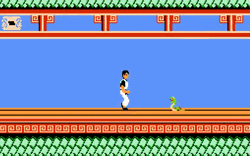 But in the same way that Space Invaders tells you everything you need to know within its title, and Pac-Man never need be anything more than a puck-shaped man, Kung-Fu’s fighting origins come from the simplest of sources: the joypad. Ever seen a Kung-Fu Master arcade cabinet? There is a completely centered joystick, punch and kick buttons on either side (seemingly to, for once, placate our left handed community), and a complete lack of a jump button. Where did jump go? It’s the up key, and that’s all it ever needed to be.
But in the same way that Space Invaders tells you everything you need to know within its title, and Pac-Man never need be anything more than a puck-shaped man, Kung-Fu’s fighting origins come from the simplest of sources: the joypad. Ever seen a Kung-Fu Master arcade cabinet? There is a completely centered joystick, punch and kick buttons on either side (seemingly to, for once, placate our left handed community), and a complete lack of a jump button. Where did jump go? It’s the up key, and that’s all it ever needed to be.
And that changes everything.
Remember Donkey Kong? Why did Mario need separate “up” and “jump” buttons? Because ladders, that’s why. Mario had to distinctly climb his way to rescuing Pauline, and, while Jump Man may have been on a 2-D plane, he needed the faux 3-D motion of “going up” to properly ascend. In some stages there were elevators or moving platforms, but “up” was a necessary way of scaling the heights. “Jump” was there not to soar, but to avoid obstacles in Mario’s path. And when Mario became Super (after the release of Kung-Fu Master, incidentally), “jump” became Mario’s offense, defense, and a way to properly climb over blocks and up towards clouds. Mario’s jump was versatile to a ridiculous degree, and time has shown the many, many ways a jump can be applied to both terrible platformers and more interesting jump-a-thons.
But the jump of Kung-Fu is a very different animal. When you jump in Kung-Fu, you are doing one of two things:
- Avoiding a low attack
- Delivering a hella rad jump kick
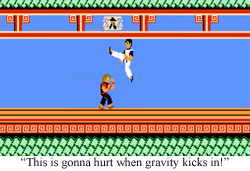 That’s it! That’s all a Kung-Fu jump does. There are no ladders to climb. There are no doors to enter. Even vaulting over an enemy is less satisfying than simply kicking that creeping snake right in the asp. The jump of Kung-Fu is there for one reason and one reason only: it is another avenue of attack. The best defense is a good offense, so the best way to avoid a million encroaching dudes is to distribute a million deadly punches. If that doesn’t work, leap over the incoming attack, and, hi-yah, jump kick to the face. Who needs “environmental hazards” when you’ve got dudes tossing friggin’ knives!?
That’s it! That’s all a Kung-Fu jump does. There are no ladders to climb. There are no doors to enter. Even vaulting over an enemy is less satisfying than simply kicking that creeping snake right in the asp. The jump of Kung-Fu is there for one reason and one reason only: it is another avenue of attack. The best defense is a good offense, so the best way to avoid a million encroaching dudes is to distribute a million deadly punches. If that doesn’t work, leap over the incoming attack, and, hi-yah, jump kick to the face. Who needs “environmental hazards” when you’ve got dudes tossing friggin’ knives!?
And that right there is the origin of the fighting game. I’ve said it before, but fighting games are pure expressions of basic concepts. Man vs. Man. Man vs. Self (mirror match). Man vs. Metal Slug. When Chun-Li experiences a particularly bad Tuesday and needs to avenge her father, she doesn’t need to jump over seventeen barrels and then successfully bop sixty turtles before finally moving onto the main boss; no, all she need do is beat ten dudes to a pulp, prove her worth in a simple 2-D plane, and advance to the tournament organizer/Magic Hitler. And, yes, Chun-Li jumps by simply tapping up, because her jump exists exclusively to necessitate various kinds of sweet kicks. In fact, upgrade for better graphics, buttons, and the occasional fireball, and Chun-Li controls exactly like Thomas the Kung-Fu Dude. And the boss of the third stage of Kung-Fu? You can’t tell me that ain’t Mike Bison Balrog.
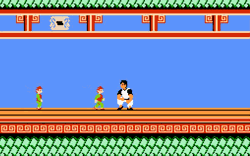 Kung-Fu might not be a true fighting game, but all the elements are starting to coalesce here in this 1984 game. Play Street Fighter, Blazblue, or even Tekken, then return to Kung-Fu, and things will seem… very familiar. It all starts with a simple jump interface, and it ends with Ryu tossing dragon punches.
Kung-Fu might not be a true fighting game, but all the elements are starting to coalesce here in this 1984 game. Play Street Fighter, Blazblue, or even Tekken, then return to Kung-Fu, and things will seem… very familiar. It all starts with a simple jump interface, and it ends with Ryu tossing dragon punches.
And the poor folks behind Kung Fu Master never get any credit…
Oh, wait, apparently Kung-Fu Master was created by Takashi Nishiyama, the man responsible for Street Fighter who then went on to SNK to start Fatal Fury, King of Fighters, and Samurai Shodown. Huh. I guess that guy knew what he was doing.
Well, nobody ever claims Moon Patrol was the start of all fighting games…
FGC #314 Kung Fu
- System: NES for the review (and certainly the version I played the most), but Kung-Fu also appeared in the arcades (duh), Apple devices, a couple of Ataris, and the Commodore 64.
- Number of players: Two player alternating. This is not the game where two guys fight in front of a judge with weird hair. That’s Karate Champ.
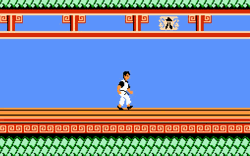 Favorite Boss: The magician at the end of the fourth stage will literally lose his head if you knock it off with a kick. He… gets better.
Favorite Boss: The magician at the end of the fourth stage will literally lose his head if you knock it off with a kick. He… gets better.- Did you know? Koji Kondo, the composer for Street Fighter 2 (and thus, Guile’s theme) composed the soundtrack for the NES version. Another fighting game connection!
- Would I play again: This is an important piece of history that is hard as steel. I might play it again for thirty seconds, but I’m totally quitting after my first death.
What’s next? Random ROB has chosen… Sonic Generations! Dammit, ROB! Sonic Mania just came out! Can’t I write about that game? Or could you have picked Sonic Generations last week, and we could have made a theme out of it? No? Damn you, robot. Fine, Sonic Generations it is. Please look forward to it!
